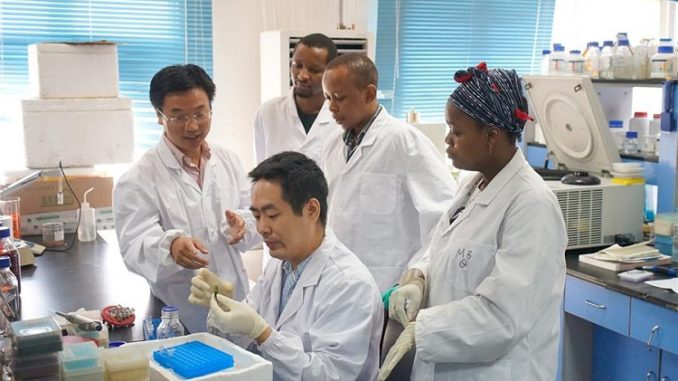
Article by Alex Lo, from the South China Morning Post.
Belt and Road Initiative is spreading science and technology across Global South.
The 10th anniversary of the massive global infrastructure program recalls how it is working closely with developing countries to acquire much-needed technical know-how for growth and development.SCMP
According to the standard Western narrative, China’s Belt and Road Initiative is all about laying debt traps and building white elephants for developing countries.The malice to China and parental condescension to those countries are too obvious. Let those countries, which have long been and still are exploited by Western states, decide for themselves. Surely, they can choose their own partners and reject suitors if they want.
As Beijing this month celebrated the anniversary of the massive infrastructure program, one significant aspect of it deserves far greater appreciation – the spread, promotion and funding of science and technology across much of the Global South.
In western Europe and North America, as research institutes, either voluntarily or under pressure from their governments, scale back or even sever collaborations with their Chinese counterparts, China has been redrawing global science by building a “New Silk Road” for science and technology with middle- and low-income countries.
While collaborations with the West, now dwindling, often involve cutting-edge science, those with the Global South usually involve more practical or life-saving technologies such as extracting clean water from waste and increasing crop yields.

These may not involve breakthroughs, but they help lay the groundwork for economic development to escape poverty.
The full scale of science development under the belt and road is quite breathtaking, regardless of your view on its more headline-grabbing infrastructure projects. As announced in Beijing this month, 100 laboratories will be built in participating countries in the next five years. Every year, the Chinese Academy of Sciences (CAS) and the Unesco World Academy of Sciences, based in Trieste, jointly fund 300 international new PhDs a year.
China is deepening scientific links with low- and middle-income countries. Europe and the United States would be wise to join this effort, which could help to resolve economic, environmental and political crises.Nature
The Pak-Austria Fachhochschule, a university focusing on science and technology, is a collaboration between Austria, China and Pakistan. Opened in 2020, its first students will graduate next year. It will also launch collaborative research centres in artificial intelligence, critical minerals and railway engineering.
This month, Pakistan and Azerbaijan announced that their space agencies would join China’s lunar research-station project, which aims to build a permanent base on the moon in the next decade.
Last month, in a joint project, the CAS, the National Museums of Kenya and the Sino–Africa Joint Research Centre, near Nairobi, started publishing a projected 31-volume study, “Flora of Kenya”, which aims to catalogue some 7,000 plant species in the African country.
Headquartered at the CAS, the Alliance of International Science Organisations has 67 research institutions from 48 countries. It also funds PhD scholarships for international students in China.

More than 1,300 graduate students from belt and road-linked countries are conducting research in Beijing that aims specifically at solving problems back home. These include removing organic matter from waste water, an acute problem in Bangladesh; and using bacteria to extract copper from low-grade ore, to extend the lives of copper mines in Myanmar. In Sri Lanka, a dedicated centre has been set up with Chinese funding to study and manage clean drinking water.
A powerful radio station in Patagonia, Argentina, played a key role in landing the Chang’e 4 spacecraft on the far side of the moon in 2019, and other operations with the current Chinese space program. Perhaps predictably, the program’s link to the Chinese military and the station’s powerful communications equipment have given Washington an excuse to claim, without evidence, that it could be conducting military and surveillance work in the western hemisphere.
Both Chile and Argentina have hosted Chinese researchers at astronomical centres and observatories in the two countries. Meanwhile, the China–Brazil Joint Laboratory for Space Weather in Sao Jose dos Campos has been developing forecast models.
This long list goes on for dozens of participating belt and road countries.
China’s scientific investments have offered an alternative to aspiring scientists and advanced students from the developing world where Western institutions were once their main choice for foreign study.
Though rarely acknowledged in the West, they have undoubtedly become a source of goodwill with many developing countries which are far more appreciative of the belt and road than the Western narrative allows.
Source: South China Morning Post, 30 Oct, 2023. https://www.scmp.com/comment/opinion/article/3239697/belt-and-road-initiative-spreading-science-and-technology-across-global-south
See also: Nature 622, (2023), ‘China’s Belt and Road Initiative is boosting science’. https://doi.org/10.1038/d41586-023-03299-6

Author: Alex Lo has been a SCMP columnist since 2012, covering major issues affecting Hong Kong and the rest of China. A journalist for 25 years, he has worked for various publications in Hong Kong and Toronto as a news reporter and editor. He has also lectured in journalism at the University of Hong Kong.